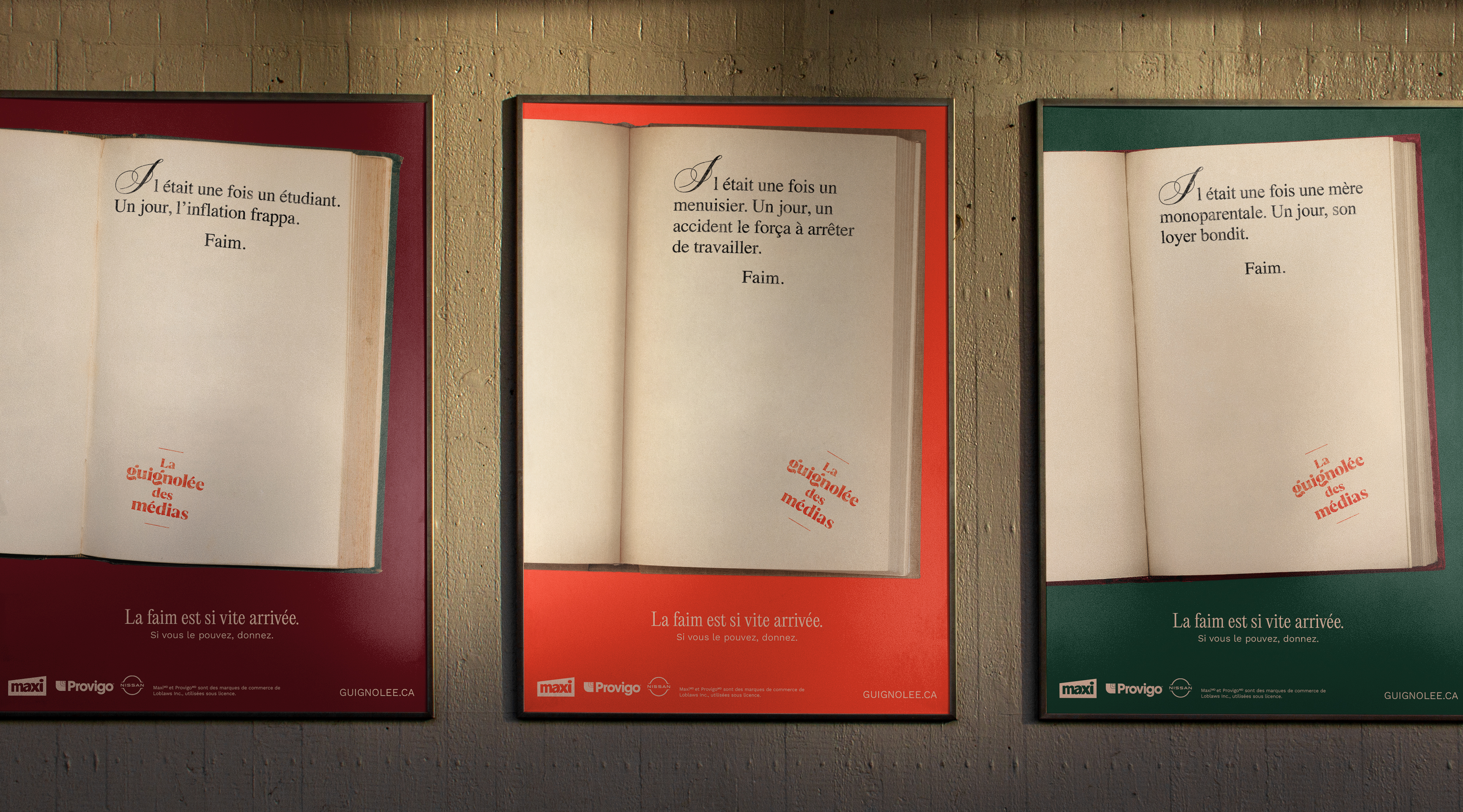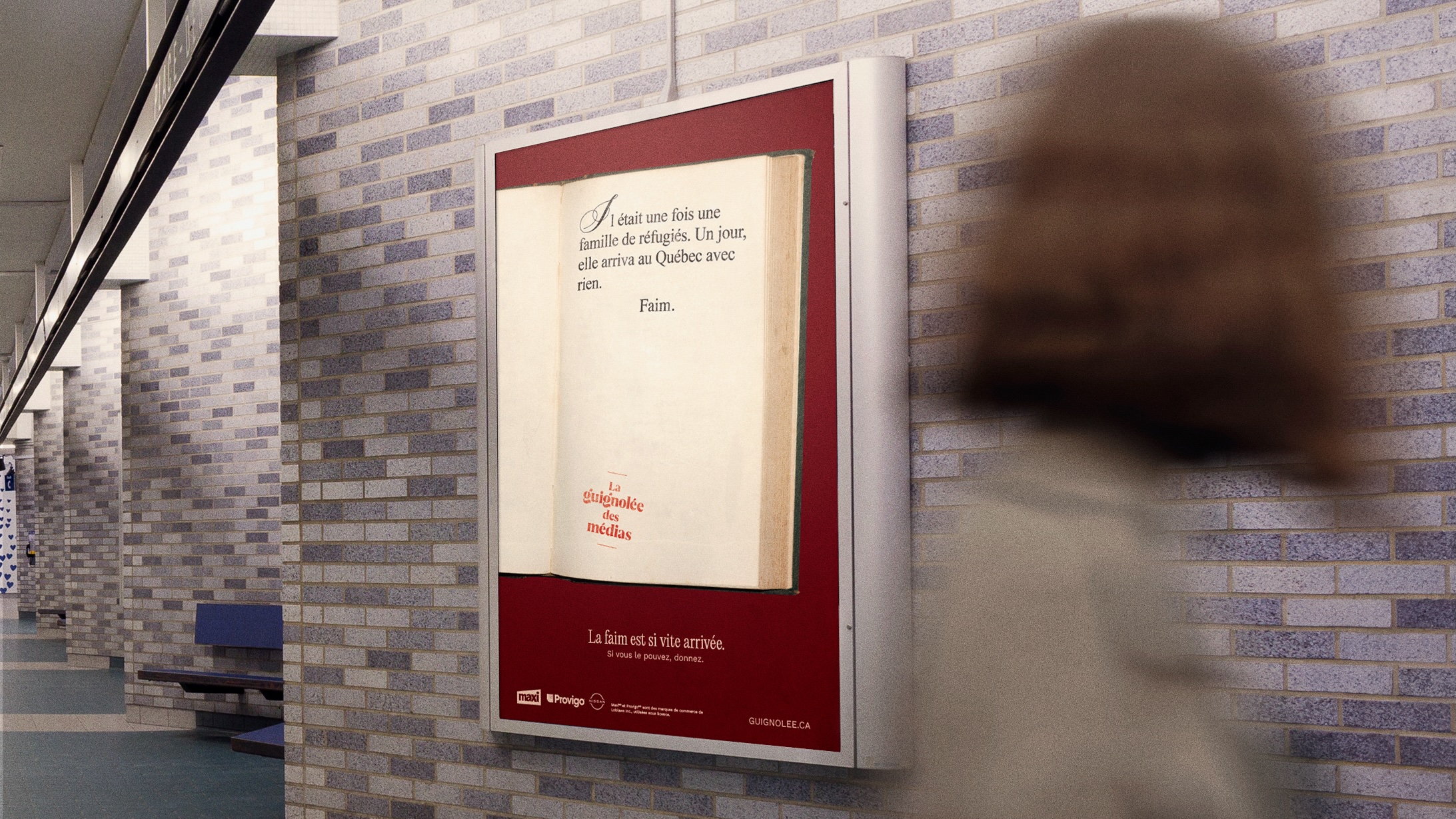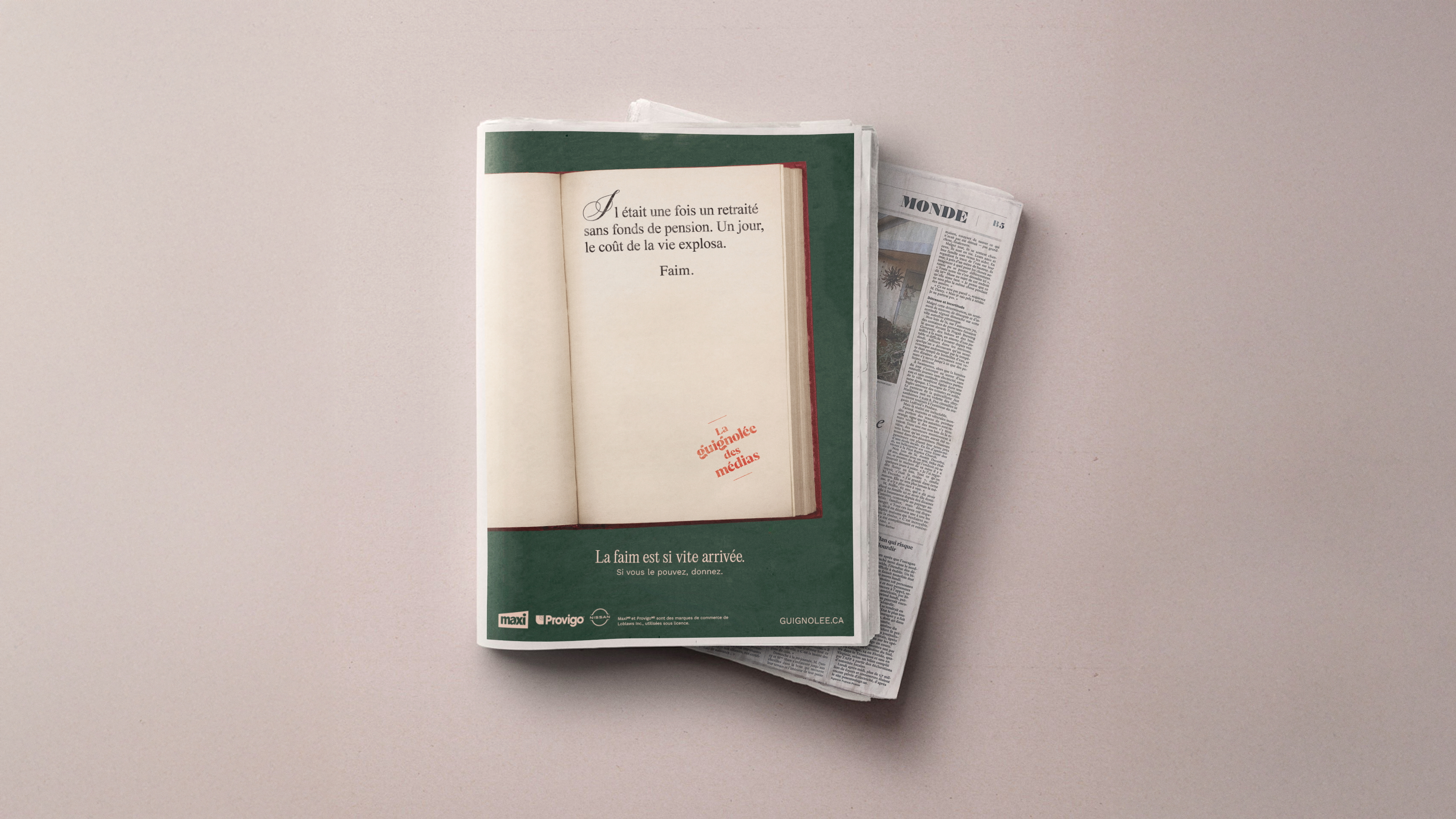2025 Winner



BronzeBest Integrated Campaign
The Media Food Drive / La guignolée des médias (180Deux)
"Hunger: The End"
Cartier
"Hunger: The End"
Cartier
For its 24th edition, The Media Food Drive faced its most urgent mission yet: raising funds and food for the nearly three million monthly food assistance requests in Quebec.
One of the brand’s biggest challenges was standing out in a fragmented media landscape during a holiday season full of charitable requests. And, most notably, the agency had to deliver results without any access to custom formats — since the campaign, backed by Quebec’s largest media groups, required a platform they could activate using standard placements.
The agency challenged itself to use these standard media formats as the message. This was the central focus of the media campaign: innovation within the constraints of traditional media. They created executions native to each medium that were impossible to ignore, that made people feel, within a few seconds, the abruptness of food insecurity.
The insight about this sudden onset came from listening to those directly affected. Food insecurity is no longer an issue on the margins of society but something anyone can face after a sudden event: a breakup, a layoff, a rent hike. Through conversations with beneficiaries and front-line workers, they uncovered a powerful truth: nowadays, hunger strikes faster than ever.
The agency wanted to tell poignant stories of sudden hardship ending abruptly with the word faim (“hunger”) — a homophone of fin (“the end”). In each piece, a life-altering moment brings hunger (faim), and with it, the abrupt ending (fin) of the narrative. Hunger shouldn’t be an ending — but here, it is.
The campaign’s media execution echoed these lived experiences: stories cut short, comfort becoming chaos. Instead of delivering a single message across all channels, they built unique narrative arcs for each medium.
On TV and online, short films ended mid-scene. In radio spots, minimalist audiobooks faded into silence the moment hunger struck. In print and OOH, novels stopped after a couple sentences. Social media formats mirrored these storytelling techniques in bite-sized, emotionally charged scripts ended abruptly by hunger. These micro-narratives leveraged the sense of interruption both as a creative device and a strategic hook.
Coordinating more than 100 media outlets required seamless partner alignment; success hinged on creative ingenuity and deep collaboration between the agency, media groups, and production partners. Measurement strategies were tailored to each medium: completion rates and qualitative feedback for traditional formats; engagement and conversion for digital. The results validated the impact of a media mix rooted in relevance, storytelling, and wide provincial reach.
The campaign’s innovation didn’t come from flashy tech or high-budget builds, but from how they reimagined traditional media by pushing each format to its emotional edge.
The agency produced possibly the world’s shortest audiobooks — narrated by beloved Canadian actresses Anne Dorval and Caroline Dhavernas — in which the listener is drawn into a compelling story that ends seconds later. Despite its brevity, the format achieved exceptional completion and engagement rates, proving that even a few seconds can carry profound emotional weight when they mirror lived experience.
At the campaign’s cinema launch event, the short films were paired with popcorn bags with false bottoms. As viewers quickly reached the “end” of their snack, they discovered they’d been short-changed — a tactile metaphor that extended the campaign’s insight into real-life experience.
These examples of unfinished tales played with the public’s expectations, leaving them both curious and unsettled. By turning standard formats into abrupt emotional experiences, the campaign stood out not just for what it said, but how it made people feel, and how it used these standard media formats in new and innovative ways.
The campaign not only met but surpassed its business objectives, delivering both record-breaking donations and widespread visibility.
$5.1 million was raised, the highest total in the 24-year history of The Media Food Drive — an increase of 61% year over year in some areas. Despite inflation and financial hardship across Quebec, the campaign broke through charitable fatigue. Over 100 media outlets activated the campaign, generating more than $500,000 in earned media value through unpaid news coverage and editorial support. The campaign also saw high engagement and completion rates across digital and audio formats, particularly for short-form executions.
The sharp year-over-year increase in contributions confirms a strong correlation between the campaign’s creative media program and its fundraising success.
In short, the campaign delivered measurable, meaningful impact, not only raising more funds than ever before, but reminding Quebecers that hunger should never be an ending. And it accomplished all this within the limits of standard formats; the agency rose to the challenge of this complex campaign, transforming its limitations into victories.
One of the brand’s biggest challenges was standing out in a fragmented media landscape during a holiday season full of charitable requests. And, most notably, the agency had to deliver results without any access to custom formats — since the campaign, backed by Quebec’s largest media groups, required a platform they could activate using standard placements.
The agency challenged itself to use these standard media formats as the message. This was the central focus of the media campaign: innovation within the constraints of traditional media. They created executions native to each medium that were impossible to ignore, that made people feel, within a few seconds, the abruptness of food insecurity.
The insight about this sudden onset came from listening to those directly affected. Food insecurity is no longer an issue on the margins of society but something anyone can face after a sudden event: a breakup, a layoff, a rent hike. Through conversations with beneficiaries and front-line workers, they uncovered a powerful truth: nowadays, hunger strikes faster than ever.
The agency wanted to tell poignant stories of sudden hardship ending abruptly with the word faim (“hunger”) — a homophone of fin (“the end”). In each piece, a life-altering moment brings hunger (faim), and with it, the abrupt ending (fin) of the narrative. Hunger shouldn’t be an ending — but here, it is.
The campaign’s media execution echoed these lived experiences: stories cut short, comfort becoming chaos. Instead of delivering a single message across all channels, they built unique narrative arcs for each medium.
On TV and online, short films ended mid-scene. In radio spots, minimalist audiobooks faded into silence the moment hunger struck. In print and OOH, novels stopped after a couple sentences. Social media formats mirrored these storytelling techniques in bite-sized, emotionally charged scripts ended abruptly by hunger. These micro-narratives leveraged the sense of interruption both as a creative device and a strategic hook.
Coordinating more than 100 media outlets required seamless partner alignment; success hinged on creative ingenuity and deep collaboration between the agency, media groups, and production partners. Measurement strategies were tailored to each medium: completion rates and qualitative feedback for traditional formats; engagement and conversion for digital. The results validated the impact of a media mix rooted in relevance, storytelling, and wide provincial reach.
The campaign’s innovation didn’t come from flashy tech or high-budget builds, but from how they reimagined traditional media by pushing each format to its emotional edge.
The agency produced possibly the world’s shortest audiobooks — narrated by beloved Canadian actresses Anne Dorval and Caroline Dhavernas — in which the listener is drawn into a compelling story that ends seconds later. Despite its brevity, the format achieved exceptional completion and engagement rates, proving that even a few seconds can carry profound emotional weight when they mirror lived experience.
At the campaign’s cinema launch event, the short films were paired with popcorn bags with false bottoms. As viewers quickly reached the “end” of their snack, they discovered they’d been short-changed — a tactile metaphor that extended the campaign’s insight into real-life experience.
These examples of unfinished tales played with the public’s expectations, leaving them both curious and unsettled. By turning standard formats into abrupt emotional experiences, the campaign stood out not just for what it said, but how it made people feel, and how it used these standard media formats in new and innovative ways.
The campaign not only met but surpassed its business objectives, delivering both record-breaking donations and widespread visibility.
$5.1 million was raised, the highest total in the 24-year history of The Media Food Drive — an increase of 61% year over year in some areas. Despite inflation and financial hardship across Quebec, the campaign broke through charitable fatigue. Over 100 media outlets activated the campaign, generating more than $500,000 in earned media value through unpaid news coverage and editorial support. The campaign also saw high engagement and completion rates across digital and audio formats, particularly for short-form executions.
The sharp year-over-year increase in contributions confirms a strong correlation between the campaign’s creative media program and its fundraising success.
In short, the campaign delivered measurable, meaningful impact, not only raising more funds than ever before, but reminding Quebecers that hunger should never be an ending. And it accomplished all this within the limits of standard formats; the agency rose to the challenge of this complex campaign, transforming its limitations into victories.
Credits
CREATIVE AGENCY: CartierPARTNER AGENCY, MEDIA RELATIONS: 180DEUX
PRODUCTION HOUSE: Romeo
SOUND STUDIO: Circonflex
COLORISATION: Mels
CLIENT: The Media Food Drive / La guignolée des médias
AGENCY - CARTIER
ACCOUNT SERVICES
VICE-PRESIDENT AND PARTNER: Audrée Couture
ACCOUNT MANAGER: Virginie Jamieson
CREATIVE
VICE-PRESIDENT AND PARTNER: Sébastien Pelletier
CREATIVE DIRECTOR: Daniel Beaumont
COPYWRITER: Guillaume Denault
ART DIRECTOR: Antoine C. Buteau
DESIGN: Mélanie Beauchamp-Boulay
ENGLISH ADAPTATION: Misha Solomon
AGENCY PRODUCER: Mélissa Lépine
MÉDIA
VICE-PRESIDENT AND PARTNER : Luis Areas
SUPERVISOR, CHANNEL STRATEGY : Marc-André Giard
STUDIO
PRODUCTION DIRECTOR: Marylène Rochefort
PRODUCTION MANAGER: Sandra St-Pierre
GRAPHICS AND PROGRAMMING: Solenne Leost, Marlène Cogez, Pierre Rochefort
MOTION DESIGNER: François Brisson, Gustafson Charles, Jean-Sébastien Smith
PRODUCTION - Romeo, Circonflex, Mels
DIRECTOR: Sophia Belahmer
ASSISTANT DIRECTOR: Sarah Massicotte
EXECUTIVE PRODUCER: France Aimy Tremblay
LINE PRODUCERS: Zoé Noël, Sarah Massicotte
LOCATION AND PRODUCTION DIRECTOR: Isabelle Tremblay
PRODUCTION MANAGER: Julien Marais
CASTING DIRECTOR: Andrée Giraldeau
DIRECTOR OF PHOTOGRAPHY: Nicolas Poitras-Gamache
OFFLINE EDITOR: Jonathan Verreault
ONLINE EDITOR: Roxanne Bonneterre
COLORIST: Jérôme Cloutier
ORIGINAL COMPOSITION: Pierre-Philippe Côté
SOUND ENGINEER: Martin Boisselle
CLIENT - The Media Food Drive / La guignolée des médias (180Deux)
COMMUNICATIONS AND MEDIA RELATIONSHIPS STRATEGIST: Isabelle Fafard
COMMUNICATIONS, SOCIAL MEDIA AND MEDIA RELATIONSHIPS STRATEGIST: Denise Deveau
